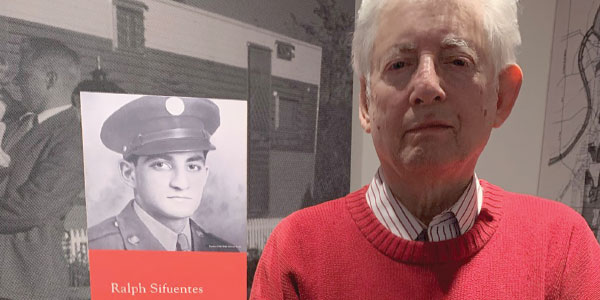
By Tere Siqueira
On Independence Day (July 4), the United States will celebrate its freedom from British rule.
Some Americans use the holiday to express their gratitude to those souls who fought for the freedoms they enjoy, whether in the Revolutionary War against Great Britain or beyond. One individual to whom they might express their gratitude is a once-forgotten hero – Ralph V. Sifuentes, the first Mexican-American from Kansas City, Missouri’s Westside neighborhood to be killed during World War II.
Born in 1921 to Cirilo and Maria Sifuentes, immigrants from Mexico who had settled in the Westside, Ralph Sifuentes was part of a tight-knit, proud Mexican community. Cirilo Sifuentes, a former fighter alongside Pancho Villa during the Mexican Revolution, and Maria Sifuentes nurtured their family amid the flavors of their Mexican heritage.
“My grandparents rented a small house at 1104 W. 24th St.,” said Ralph Sifers, Ralph V. Sifuentes’ son. “They were a very proud Mexican family. The house was always filled with music, dancing and great food. They were poor, but they had a lot of love for each other and their Mexican community.”
According to Sifers, his father enlisted in the U.S. Army’s 853rd Engineer Aviation Battalion during World War II and trained to build air bases for military operations. His unit was dispatched to Oran, Algeria, in North Africa and was bound for Bombay, India, to construct air bases for the B-29 bomber.
But on Nov. 26, 1943, their transport ship, the HMT Rohna, was hit by one of the first radio-guided missiles ever launched in war. The attack claimed the lives of 1,015 U.S. service members, including 22-year-old Ralph Sifuentes. The incident is the subject of “Rohna Classified,” an in-production documentary (see June 1 issue).
The attack’s aftermath was shrouded in secrecy, as the government declared the disaster classified and forbade survivors from speaking about it, Sifers said. The Sifuentes family and others with loved ones on that ship were left without answers.
For more than six decades, the tragedy was wrapped in silence. Then, research by family members revealed the truth about the Rohna and the attack that had taken Sifuentes’ life.
“Once the truth was discovered, my aunt told the story of what really (had) happened and sent it out to me and a number of my cousins,” Sifers said. “Included were copies of the telegrams, a letter from the War Department with vague details of the incident ‘for reasons of military security,’ pictures of the ship and where it went down in the Mediterranean.”
Despite the immense grief and hardship felt from a lack of closure, Ralph Sifuentes’ family and the Westside remember him with pride and honor. American Legion Post 437 is named after him. In addition, his portrait adorns the walls of the Sacred Heart Guadalupe Church in the Westside and the Kansas City Museum, located in the Northeast neighborhood.
“There are many theories as to why it was kept a secret,” Sifers said. “Maybe to keep the American public from knowing that the Germans had this technology, which may have caused a panic. Or perhaps to keep the families from knowing how ill-equipped the ships were to fend off such an attack. Probably both.”
“I understand why they did it, but it wasn’t fair to the families,” he added. “It wasn’t fair to my grandparents. They had a sadness in their eyes for the rest of their lives.”
La historia de sacrificio de Sifuentes es recordada y compartida
El Día de la Independencia (4 de julio), Estados Unidos celebrará su libertad del dominio británico.
Algunos estadounidenses aprovechan la festividad para expresar su gratitud a aquellas almas que lucharon por las libertades de las que disfrutan, ya fuera en la Guerra de la Independencia contra Gran Bretaña o más allá. Una persona a la que podrían expresar su gratitud es un héroe de antaño olvidado: Ralph V. Sifuentes, el primer mexicano-estadounidense del vecindario Westside de Kansas City, Missouri, que falleció durante la Segunda Guerra Mundial.
Nacido en 1921, hijo de Cirilo y María Sifuentes, inmigrantes mexicanos establecidos en el Westside, Ralph Sifuentes formaba parte de una comunidad mexicana muy unida y orgullosa. Cirilo Sifuentes, antiguo combatiente junto a Pancho Villa durante la Revolución Mexicana, y María Sifuentes criaron a su familia entre los sabores de su herencia mexicana.
“Mis abuelos rentaban una casita en el 1104 W. de la calle 24”, cuenta Ralph Sifers, hijo de Ralph V. Sifuentes. “Eran una familia mexicana muy orgullosa. La casa siempre estaba llena de música, baile y buena comida. Eran pobres, pero se querían mucho entre ellos y a su comunidad mexicana”.
Según Sifers, su padre se alistó en el 853º Batallón de Ingenieros de Aviación del ejército estadounidense durante la II Guerra Mundial y se entrenó para construir bases aéreas para operaciones militares. Su unidad fue enviada a Orán (Argelia), en el norte de África, y se dirigía a Bombay (India) para construir bases aéreas para el bombardero B-29.
Pero el 26 de noviembre de 1943, su buque de transporte, el HMT Rohna, fue alcanzado por uno de los primeros misiles guiados por radio lanzados en la guerra. El ataque cobró la vida de 1,015 miembros del servicio estadounidense, entre ellos Ralph Sifuentes, de 22 años. El incidente es el tema de “Rohna Classified”, un documental en fase de producción (puede consultarse en nuestra edición del 1 de junio).
Las secuelas del ataque estuvieron envueltas en secretismo, ya que el gobierno declaró el catástrofe como misión clasificada y prohibió a los supervivientes hablar de ella, según Sifers. La familia Sifuentes y otras personas con seres queridos en aquel barco se quedaron sin respuestas.
Durante más de seis décadas, la tragedia estuvo envuelta en el silencio. Entonces, las investigaciones de los familiares revelaron la verdad sobre el Rohna y el ataque que acabó con la vida de Sifuentes.
“Una vez descubierta la verdad, mi tía contó la historia de lo que realmente (había) ocurrido y nos la envió a mí y a varios de mis primos”, cuenta Sifers. “Se incluían copias de los telegramas, una carta del Departamento de Guerra con vagos detalles del incidente ‘por razones de seguridad militar’, fotos del barco y del lugar donde naufragó en el Mediterráneo”.
A pesar de la inmensa pena y las dificultades que se sienten por la falta de un cierre, la familia de Ralph Sifuentes y el Westside le recuerdan con orgullo y honor. El puesto 437 de la Legión Americana lleva su nombre. Además, su retrato adorna las paredes de la iglesia del Sagrado Corazón de Guadalupe, en el Westside, y del Museo de Kansas City, situado en el Noreste de la ciudad.
“Hay muchas teorías sobre por qué se mantuvo en secreto”, dijo Sifers. “Tal vez para evitar que el público estadounidense supiera que los alemanes disponían de esta tecnología, lo que podría haber provocado el pánico. O tal vez para evitar que las familias supieran lo mal equipados que estaban los barcos para defenderse de un ataque así. Probablemente ambas cosas”.
“Entiendo por qué lo hicieron, pero no fue justo para las familias”, añadió. “No fue justo para mis abuelos. Tuvieron una tristeza en los ojos para el resto de sus vidas”.









